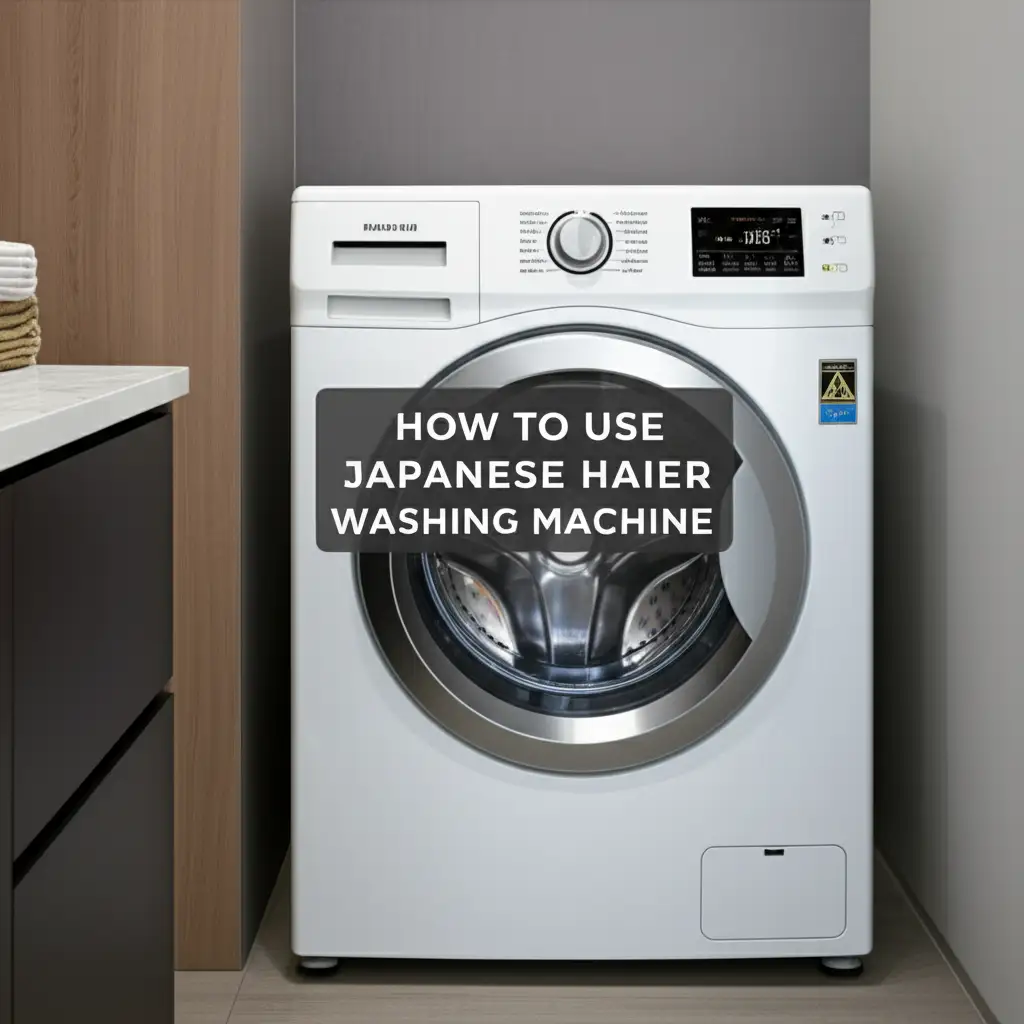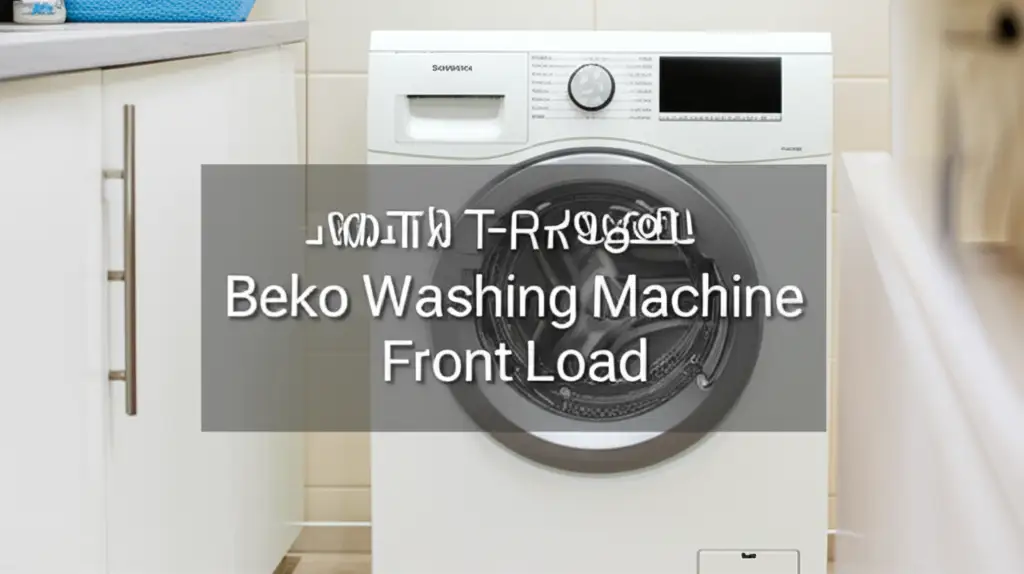· Todd Martin · Home Appliances · 21 min read
How To Use Japanese Haier Washing Machine

Mastering Your Japanese Haier Washing Machine
Moving to Japan brings many exciting changes, including new home appliances. Your Japanese Haier washing machine might look different from models you know. It often features unique symbols and cycles. Learning how to operate this essential appliance is key to smooth daily living. This guide helps you understand every button and setting. You will soon wash your clothes with confidence. I will walk you through controls, wash cycles, and care steps. This article helps you make the most of your machine.
Takeaway
- Understand the Control Panel: Learn common Japanese characters and symbols for basic functions.
- Load Correctly: Avoid overloading and use appropriate detergents designed for Japanese machines.
- Select the Right Cycle: Choose from common programs like “Standard,” “Quick,” or “Delicate” for best results.
- Perform Regular Maintenance: Clean filters and dispensers to keep your machine working well.
- Troubleshoot Simple Issues: Address minor problems like error codes or unusual noises yourself.
Using a Japanese Haier washing machine involves understanding its control panel, which uses Japanese characters and international symbols. You add detergent, select a wash cycle based on fabric type, and press start. Regular cleaning of filters and dispensers ensures good performance.
Understanding Your Japanese Haier Washing Machine’s Control Panel
Your Japanese Haier washing machine’s control panel is the main interface. It helps you select wash settings. Many buttons have Japanese text, but also use universal symbols. Understanding these symbols is your first step. I found that familiarizing myself with common characters made a big difference.
The panel often includes buttons for power, start/pause, and cycle selection. You will also see options for water level and rinse cycles. Look for clear icons representing different functions. A quick reference sheet for common Japanese laundry terms can be very helpful here.
Deciphering Common Buttons and Symbols
Japanese washing machines use specific terms for their settings. For example, “電源” (dengen) means power, and “スタート/一時停止” (sutāto/ichiji teishi) means start/pause. You will also see “コース” (kōsu) for cycle or course selection. This button lets you pick the wash program. “水量” (suiryō) controls the water level, useful for different load sizes.
Many Haier models also use universal symbols. A bucket with water represents the wash cycle. A swirling arrow shows the spin cycle. A dripping water symbol means rinse. These symbols make it easier to guess functions even without knowing the Japanese text. Familiarize yourself with these basic icons for confident use.
You will often see separate buttons for “洗い” (arai - wash), “すすぎ” (susugi - rinse), and “脱水” (dassui - spin). Sometimes, these are combined into a single cycle selector. Some machines might have an “予約” (yoyaku) button, which allows you to set a delayed start. This feature is great for timing your laundry. I use it often to have clothes ready when I wake up.
Navigating Basic Settings
Setting up a wash cycle involves a few steps. First, turn on the power button. Then, choose your desired wash course. Common options include standard, delicate, or quick wash. After selecting the course, adjust the water level if your machine offers manual control. Some models automatically detect the load size and set the water level.
You may also find options for temperature settings, though many Japanese Haier machines primarily use cold water. If your machine heats water, look for a “温度” (ondo) setting. This adjusts the water temperature for the wash. Finally, press the start button. The machine begins its cycle.
Understanding these basic settings allows you to customize your wash. This helps you care for different fabric types. Knowing what each button does means you can properly use your machine. This helps you avoid common mistakes. Many of these machines function similarly to other fully automatic models. If you have used a Haier fully automatic washing machine before, you will find many similarities. For more details on using a fully automatic model, you can refer to our guide on how to use Haier washing machine fully automatic.
Some Japanese Haier washing machines have advanced features. These include special care modes or self-cleaning cycles. Look for a “槽洗浄” (sō senjō) button for tub cleaning. This keeps your machine fresh. Regular use of this cycle prevents mold build-up. I always make sure to run this cycle once a month. This keeps my machine clean and odor-free.
Loading Your Japanese Haier Washing Machine Correctly
Properly loading your Japanese Haier washing machine is vital. It affects cleaning performance. It also helps preserve your clothes. An overloaded machine will not clean well. It can also strain the motor. A machine that is too empty wastes water and energy. I always aim for a balanced load.
Before loading, check clothing pockets for small items. These can damage the machine. Separate whites from colors to prevent color bleeding. Also, separate heavy items like jeans from delicate items. This ensures each item gets the right wash.
Optimal Load Size and Detergent Dispenser
For optimal cleaning, fill your machine about three-quarters full. This leaves enough space for clothes to move freely. Proper movement allows detergent and water to circulate effectively. If your machine is a top-loader, ensure clothes are below the water line. If it is a front-loader, do not pack clothes tightly. This applies to any front-load model, including your Haier. You can learn more about general front-load usage here: how to use Haier washing machine front load.
Your Japanese Haier washing machine has a specific detergent dispenser. This is usually a tray or compartment. It often has separate sections for detergent, fabric softener, and bleach. Detergent goes into the main wash compartment. Fabric softener goes into a smaller, often marked compartment. Bleach might have its own section or be added directly to the drum. Always check your specific model’s manual for dispenser layout. Using the correct amount of detergent is important. Too much can leave residue. Too little might not clean clothes well.
What Detergents to Use in Japan
Japanese detergents are formulated for local water conditions. They are also designed for Japanese washing machines. These machines often use less water than Western models. This means Japanese detergents are usually highly concentrated. They create less suds. Using too much foreign detergent can create excessive suds. This might trigger error codes or affect rinsing.
Look for detergents labeled “液体洗剤” (ekitai senzai - liquid detergent) or “粉末洗剤” (funmatsu senzai - powder detergent). You can also find “ジェルボール” (jeru bōru - gel balls), which are convenient pre-measured pods. For fabric softener, look for “柔軟剤” (jūnan zai). Always follow the dosage instructions on the detergent package. These instructions are typically in milliliters or grams, often with diagrams. Japanese water temperature might impact detergent performance. Understanding if your machine heats its own water can help you choose the right detergent. For more information, see our guide on does Haier washing machine heat its own water.
I found that Japanese detergents often come with pleasant, subtle scents. They are effective even in colder water washes, which are common in Japan. Always store detergents safely away from children and pets. Choosing the right detergent is a small step, but it makes a big difference in your laundry results.
Essential Wash Cycles and Programs on Japanese Haier Models
Japanese Haier washing machines offer various wash cycles. Each cycle is for a specific type of fabric or washing need. Knowing these cycles helps you protect your clothes. It also helps you achieve the best cleaning results. I always choose the cycle that matches my load. This prevents damage and saves energy.
Most machines have standard cycles. They also include specialized programs. These programs handle delicate items or quick washes. Understanding the purpose of each one helps you use your machine efficiently. It prevents common laundry mishaps.
Common Cycle Names and Their Uses
Here are some common wash cycles you will find:
- 標準 (Hyōjun - Standard): This is your everyday cycle. It is suitable for most cottons and mixed fabrics. It includes a wash, rinse, and spin. This cycle balances cleaning power with energy efficiency. I use this for most of my regular clothes.
- おいそぎ (Oisogi - Quick Wash/Speedy): This cycle is for lightly soiled clothes or small loads. It uses less water and finishes faster. It is perfect for items you need quickly. This cycle is not for heavily soiled clothes.
- ソフト/おしゃれ着 (Soft/Osharegi - Delicates/Fashionable Clothes): This cycle uses gentle agitation. It has a slower spin speed. It is for delicate fabrics like silk, wool, or lingerie. Use a mesh laundry bag for extra protection.
- 毛布 (Mōfu - Blanket): This cycle handles large, bulky items like blankets or comforters. It uses more water. It often has a unique tumbling action.
- 槽洗浄 (Sō Senjō - Tub Clean): This is a self-cleaning cycle for the washing machine drum. It helps remove detergent residue, mold, and odors. Run this cycle regularly, typically once a month, with a washing machine cleaner. This keeps your machine fresh.
Some models may also have cycles like “ドライ” (dorai - dry, for very delicate items that mimic hand washing) or “つけおき” (tsukeoki - soak). Knowing these cycles means you can tackle any laundry challenge.
Special Features (e.g., Eco, Delicates, Quick Wash)
Beyond the basic cycles, Japanese Haier machines often include special features. These enhance your washing experience.
- エコ (Eco - Economy): This mode saves energy and water. It often uses lower temperatures or longer wash times for efficiency. It is good for general loads when you are not in a hurry.
- 風呂水 (Furomizu - Bath Water): Some models have an option to use bath water for the wash cycle. This is a common feature in Japan. It helps conserve water. A special hose connects to your bathtub. This feature is very environmentally friendly.
- 風乾燥 (Fūkansō - Air Dry/Wind Dry): This is not a full drying cycle. It uses air circulation and spin to remove more moisture. It reduces drying time, especially for items you hang to air dry. It helps clothes dry faster indoors. This is very useful during humid seasons.
- チャイルドロック (Child Lock): This feature locks the control panel. It prevents children from changing settings or opening the door during a cycle. To engage it, you often press and hold a specific button combination for a few seconds. This feature provides peace of mind. For help with a locked machine, including the child lock, you can check our guide on how to open Haier washing machine when locked.
Using these special features correctly helps you get the most out of your Haier washing machine. They offer flexibility and efficiency. I find the bath water feature particularly helpful for reducing my water bill.
Starting a Wash and Basic Troubleshooting Tips
Once you understand the controls and selected your cycle, starting a wash is simple. However, sometimes issues can arise. Knowing basic troubleshooting steps can save you time. It might prevent an unnecessary service call. I always try simple fixes first.
This section covers the typical steps for initiating a wash cycle. It also explains how to handle common problems like error codes or unexpected stops. Most issues have straightforward solutions. You can resolve them yourself.
Initiating a Cycle and Adjusting Settings
- Load the Machine: Place your sorted clothes into the drum. Do not overload it.
- Add Detergent and Softener: Pour liquid or powder detergent into the main wash compartment. Add fabric softener to its designated slot.
- Power On: Press the “電源” (dengen) button to turn on the machine.
- Select Cycle: Use the “コース” (kōsu) button or dial to choose your desired wash program (e.g., 標準 – Standard).
- Adjust Settings (Optional): If available, adjust water level (水量 – suiryō), rinse cycles (すすぎ – susugi), or temperature (温度 – ondo).
- Start Wash: Press the “スタート/一時停止” (sutāto/ichiji teishi) button to begin the cycle. The machine will fill with water and start washing.
During the cycle, you may hear various sounds. These are normal operating noises. If you need to add an item, press the start/pause button. Wait for the door to unlock, usually after a few seconds, then add the item and press start again.
Common Error Codes and Quick Solutions
Japanese Haier washing machines use error codes to indicate problems. These codes usually appear on the digital display. Referring to your machine’s manual provides the most accurate information. However, some codes are very common:
- E1 or C1 (Drainage Problem): This means the machine cannot drain water.
- Solution: Check if the drain hose is bent, kinked, or clogged. Ensure the drain pump filter is clean. Sometimes, the issue relates to the machine not draining properly. For more detailed solutions, check our guide on why is my Haier washing machine not draining.
- E2 (Door/Lid Not Closed): The machine detects the door or lid is not securely shut.
- Solution: Close the door or lid firmly. Make sure no clothes are stuck in the seal. This is a common and easy fix. For more specific information on this error, you can read about what does e2 mean on Haier washing machine.
- E4 (Water Inlet Problem): The machine is not filling with water or filling too slowly.
- Solution: Check if the water tap is fully open. Ensure the water inlet hose is not bent or blocked. Clean the filter screen on the inlet valve if it is dirty.
- FC2 (Water Level Sensor Error): This indicates a problem with the water level detection.
- Solution: Turn off the machine, unplug it for a few minutes, then restart. If the error persists, it might require professional attention. This error is common and has specific fixes. You can find more details on how to fix fc2 error in Haier washing machine.
If your machine keeps stopping without an error code, it might be due to an unbalanced load. Rearrange the clothes evenly inside the drum. This often solves the issue. For more general troubleshooting about stopping issues, refer to our article on why does my Haier washing machine keep stopping. Always try these simple steps before calling for service.
Maintaining Your Japanese Haier Washing Machine for Longevity
Regular maintenance keeps your Japanese Haier washing machine running smoothly. It prevents costly repairs. It also ensures your clothes come out clean and fresh. Ignoring maintenance can lead to bad odors, poor washing, or even machine breakdown. I make sure to clean my machine regularly.
Proper care includes cleaning specific parts. It also involves taking steps to prevent common issues like mold and mildew. This helps extend the life of your appliance. A well-maintained machine is also more energy-efficient.
Cleaning the Filter and Dispenser
One of the most important maintenance tasks is cleaning the lint filter. Most Japanese Haier washing machines have a lint filter. This filter collects lint and debris from your clothes. It is usually located at the bottom of the machine, or sometimes inside the drum. I clean mine after every few washes.
- Lint Filter: To clean, locate the filter cover. Open it and carefully pull out the filter. Remove any accumulated lint, hair, or small objects. Rinse the filter under running water. Ensure it is completely clean before putting it back. A dirty filter reduces drainage efficiency and can cause problems. For a full guide on this, you can check out how to clean filter on Haier washing machine.
- Detergent Dispenser: The detergent and softener dispenser can accumulate residue. This leads to blockages. Remove the dispenser tray from the machine. Wash it thoroughly under warm water. Use a small brush to remove any hardened detergent. Rinse well and dry before replacing it. This prevents sticky buildup and ensures proper dispensing of products.
- Water Inlet Valve Filter: Less frequently, you may need to check the water inlet valve filters. These tiny screens prevent sediment from entering your machine. They are usually located where the water hoses connect to the back of the machine. Turn off the water supply before checking them. Gently remove and clean any debris. For a step-by-step guide on this, read our article on how to clean water inlet valve on Haier washing machine.
Preventing Mold and Odors
Japanese climates can be humid. This makes washing machines prone to mold and mildew. These growths cause unpleasant odors. They can also transfer to your clothes. Preventing mold is crucial for a fresh-smelling laundry.
- Leave the Lid/Door Open: After each wash, leave the washing machine lid or door ajar. This allows air to circulate inside the drum. It helps dry out any residual moisture. This simple step greatly reduces mold growth.
- Wipe Down the Drum and Gasket: Regularly wipe the inside of the drum with a clean cloth. For front-load machines, pay special attention to the rubber gasket around the door. This area traps water and can become a breeding ground for mold. Use a mild anti-mold solution if needed.
- Run a Tub Clean Cycle: As mentioned before, run the “槽洗浄” (sō senjō) or Tub Clean cycle regularly. Use a washing machine cleaner designed for this purpose. These cleaners come in powder or liquid form. They effectively remove buildup and sanitize the drum. I run this cycle once a month. It keeps my machine smelling fresh.
- Use Proper Detergent Amounts: Using too much detergent can lead to excessive suds. This leaves residue inside the machine. This residue becomes food for mold. Always follow the manufacturer’s recommendations for detergent dosage.
By following these maintenance tips, your Japanese Haier washing machine will remain efficient and clean. This extends its lifespan. It also ensures your clothes are always fresh.
Advanced Tips for Optimal Laundry in Japan
Beyond basic operation, certain advanced tips can help you achieve even better laundry results in Japan. These tips consider local conditions. They also leverage specific features of Japanese washing machines. I have found these strategies very effective.
Understanding water properties and optimizing cycle choices makes a big difference. It helps you get the most from your appliance. It also ensures your clothes receive the best care.
Understanding Water Hardness and Temperature
Japanese tap water tends to be softer than in many other countries. Soft water means you often need less detergent. Too much detergent in soft water can cause excessive suds. It can also leave residue on clothes. Adjust your detergent dosage accordingly. This helps prevent buildup in your machine.
Many Japanese washing machines primarily use cold water for washing. This is due to energy efficiency goals and plumbing setups. While some models may have a heating element, it is less common for the main wash cycle. If your machine does not heat water, choose detergents formulated for cold water effectiveness. You might also want to pre-treat stains more diligently. Hot water is sometimes used for specific cycles like “槽洗浄” (tub clean) for sanitization. For more details on whether Haier machines heat their own water, see our article on does Haier washing machine heat its own water.
I have found that using a good quality cold-water detergent is key. It ensures effective cleaning even without hot water. Sometimes, soaking heavily soiled items before washing helps.
Utilizing Special Modes and Features
Japanese Haier washing machines often come with innovative features. These features are designed for convenience and efficiency.
- Pre-Soak Function (つけおき - Tsukeoki): This feature allows clothes to soak before the main wash. It is great for heavily soiled items or tough stains. Select this option before starting the main cycle. The machine will fill, soak, and then proceed with the wash.
- Customizable Programs: Some advanced models allow you to save custom wash programs. If you often wash specific types of clothes, you can create and save your preferred settings. This saves time during future washes. Check your manual for “My Course” or “Memory” functions.
- Delayed Start (予約 - Yoyaku): This feature lets you set a timer for the wash cycle to start later. You can load the machine at night and have it finish in the morning. This is useful for taking advantage of off-peak electricity rates if applicable. It also means you can avoid leaving wet clothes in the drum for too long.
- Drying Assistance (風乾燥 - Fūkansō): As mentioned, this is not a full dryer. However, it uses strong spin and air circulation. It removes more moisture than a regular spin. For those who air-dry clothes, this feature significantly reduces drying time. It is especially helpful during rainy seasons.
- Gentle Tumble for Delicates: Many Haier models have very gentle cycles for delicate items. These cycles might use less aggressive tumbling or a shower-like rinse. Always check the garment care label. Use a mesh laundry bag for extra protection.
Learning to use these advanced functions helps you maximize your machine’s capabilities. It makes your laundry routine more efficient and tailored to your needs. Experiment with them to see what works best for your household.
Safety and Best Practices for Using Your Japanese Haier Washing Machine
Using any appliance requires following safety guidelines. Your Japanese Haier washing machine is no exception. Adhering to best practices ensures your safety. It also prolongs the life of the machine. I always prioritize safety around my appliances.
This section covers important safety features. It also outlines crucial handling advice. Knowing when to seek professional help is also essential. These steps contribute to safe and effective operation.
Child Lock and Power Considerations
- Child Lock (チャイルドロック - Child Lock): Most Haier washing machines include a child lock feature. This prevents children from tampering with the controls or opening the lid/door during operation. To activate, look for a button or combination of buttons labeled with a lock symbol. You usually press and hold it for a few seconds. This feature provides peace of mind in households with young children. If your machine is locked and you cannot open it, consult our guide on how to open Haier washing machine when locked.
- Power Supply: Japanese household electricity is 100V. Your Haier washing machine is designed for this voltage. Ensure your outlet matches this requirement. Avoid using extension cords unless they are heavy-duty and rated for appliance use. Always plug the machine directly into a dedicated wall outlet if possible. Unplug the machine when performing maintenance or if you will be away for an extended period.
- Water Connection: Ensure the water inlet hoses are securely connected. Check for leaks periodically. Turn off the water taps when the machine is not in use for extended periods. This prevents potential water damage from leaks.
Proper electrical and water connections are fundamental for safe operation. Never try to force connections. Always consult a professional if unsure.
When to Seek Professional Help
While many issues can be resolved with basic troubleshooting, some problems require professional assistance. Knowing when to call a technician saves you time and prevents further damage.
- Persistent Error Codes: If an error code (like E1, E4, FC2) persists after you have tried the basic troubleshooting steps, a deeper issue might be present. This could indicate a sensor malfunction or a component failure.
- Unusual Noises: While some operational noises are normal, very loud grinding, banging, or screeching sounds are not. These might indicate a problem with the motor, drum bearings, or pump. If your Haier washing machine is making unusually loud noises, it is a sign to seek professional help. You can learn more about this in our article on why is my Haier washing machine so loud.
- Water Leaks: If you notice significant water leaks from the machine’s base or hoses, turn off the water supply and unplug the machine immediately. Leaks can cause significant damage. They also create electrical hazards.
- Machine Not Starting or Stopping Unexpectedly: If the machine does not power on, or if it consistently stops mid-cycle without a clear error code (and you have checked for unbalanced loads), there could be an electrical or mechanical fault. Sometimes a machine might keep stopping for various reasons. For troubleshooting specific to this issue, read our article on why does my Haier washing machine keep stopping.
- Burning Smell or Smoke: Any burning smell or visible smoke from the machine requires immediate disconnection from power. Do not attempt to use it again. This indicates a serious electrical fault.
For these situations, contact Haier customer service in Japan or a certified appliance repair technician. Attempting complex repairs yourself can be dangerous. It can also void your warranty. Always prioritize safety over trying to fix something beyond your expertise.
FAQ Section
Q1: Can I use regular detergent in a Japanese Haier machine?
You can use regular detergent, but Japanese detergents are often more concentrated. They are formulated for local water conditions and typically create fewer suds. Using too much foreign detergent can cause excessive suds, which may lead to poor rinsing or error codes. Always follow the dosage instructions on Japanese detergent packages for best results.
Q2: How do I select the water temperature on my Haier washing machine?
Many Japanese Haier washing machines primarily use cold water for washing cycles. Some models may offer a specific “温度” (ondo) button or setting for temperature control, usually for hot rinses or special cycles like tub clean. If your machine doesn’t have a visible temperature control, it likely uses cold water for the main wash.
Q3: What if the machine stops mid-cycle?
If your Japanese Haier washing machine stops mid-cycle, first check the display for any error codes. Common reasons include an unbalanced load, which you can fix by redistributing clothes. Also, check for power interruptions or water





